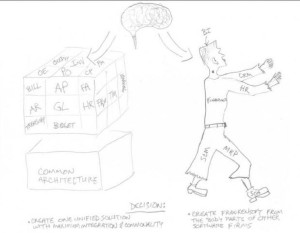[The impetus for this post, first published 2-21-2015, was some absolute nonsense online which sort of equated SaaS to “cloud” (and faux “cloud” at that), then suggested that, while customers might save a little in the short run with SaaS, it would cost them more in the long run (here using a strictly in-house TCO cost model without much attention paid to upgrades, process modernization, etc.), and then went on to annoy the hell out of me by saying that the only one who benefits from SaaS is the vendor. This was so entirely misguided a discussion, that I couldn’t help myself from ranting online, but clearly a little more needed to be said and, perhaps, more calmly. Now here I am, eighteen months later, updating and republishing this post because of some equally misguided stuff floating around that suggests, with a straight face, that currently on-premise HCM customers can achieve the benefits of true SaaS by implementing their vendor’s new HCM (or, for that matter, Finance) software on-premise. For the record, I use a very strict definition of SaaS and will continue to do so, so none of this new software which can be implemented on-premise qualifies for me as SaaS.]
In my view, there has been entirely too much attention paid when discussing true SaaS (let alone when discussing all of the FrankenSoft — a term coined by Brian Sommer from whose post on this I “borrowed” the above graphic — and hybrid variations) to the licensing, maintenance and operational costs of on-premise, last generation business applications compared to the subscription costs of similarly titled true SaaS applications. While these costs matter, I believe that the more important discussion is around the greater breadth, availability, and pace of adoption of business-enabling innovations delivered via the architecture and business model of true SaaS.
Unless your organization is operating in the same environment as it did 20+ years ago, doing pretty much the same things within pretty much the same competitive landscape (and this is true for NO ONE), then the cost of technology-enabled innovation should be the focus of any cost comparison between on-premise or faux SaaS/”cloud” and true SaaS. The speed, ease, quality and cost of delivered innovation, as well as the ease with which that innovation is adopted and used to modernize HCM processes, are the real differentiators between the best of true SaaS and the best of on-premise — and it’s this innovation which is desperately needed by today’s organizations in order to stay relevant, let alone to succeed.
However, if your vendor has a hodge podge of bought and built architectures, object models (or even worse, old timey data models), development tools, and more moving parts than you can count, they’re at a distinct disadvantage when it comes to delivering true SaaS innovation no matter how good their intentions, how large and skilled their team, or how cleverly they reinvent themselves. Throw in a range of hybrid, on-premise, hosted and true SaaS applications, and just keeping global regulatory requirements up-to-date across this portfolio — a really big deal in HCM applications — requires substantial resources.
And even as your vendor’s team is refactoring like mad to ensure as much commonality as possible across a hodge podge portfolio, which some are doing with considerable skill and progress, every dollar spent on this type of refactoring is a dollar that’s not available to drive and deliver innovation. The more moving parts, the more it costs just to keep things moving, and that’s true no matter how able the vendor may be to deploy thousands of developers.
Now every vendor must refactor continuously at some level, but having to do so across disparate moving parts is fraught with opportunities for disconnects, quality problems, and just plain slower time, higher cost, and less robustness-to-market. But those vendors who had the luxury of:
- starting over for true SaaS, whether as new companies without an installed base or as startups within established companies (and there are some exciting skunk works in our industry);
- designing and building elegant, clean architectural and object model foundations;
- taking advantage from day one of all that’s available in technology today;
- planning for and adopting rapidly the technologies to come; and especially
- rethinking their underlying object models and end-to-end processes for the 21st century rather than deriving them from 20+ and 30+ year old HCM concepts embedded in last generation on-premise applications so as to provide as much backward compatibility as possible;
those are the vendors with a distinct advantage.
My hat’s off to my very smart colleagues pushing the innovation bow wave in front of disparate and/or heavily code-based systems with the arm of a fresh start tied behind their backs. And I admire the effective marketing that such vendors are doing to dismiss the important distinctions between true and faux SaaS, and between true cloud and traditional hosting. But in the end, I hope that this generation of customers won’t be fooled — as many in the last generation were when they bought old mainframe code dressed up to act sort of like client server rather than actual new client server code — for it’s a universal truth that a fool and his money is soon parted.
